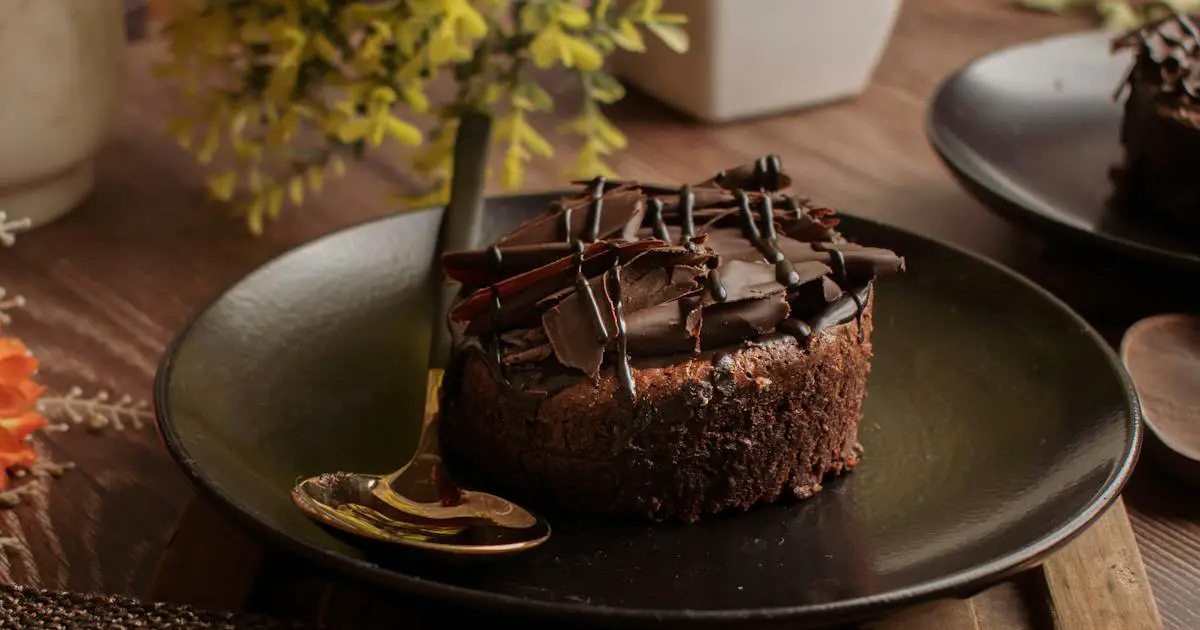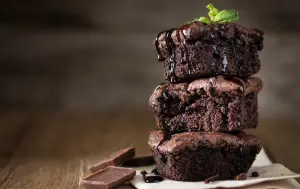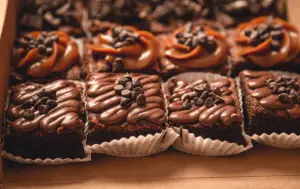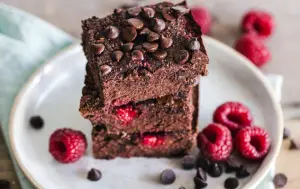The humble brownie has a fascinating and rich history, and it is a treat that millions of people enjoy worldwide. But have you ever wondered which country came up with brownies? This question leads us on a fascinating culinary journey, uncovering the brownie’s origins. The history of Brownies is as rich as its flavors, starting from early recipes to today’s varieties. In this article, we’ll explore how brownies became popular and how cultures worldwide adapted them, delving into the intriguing question of “Which Country Invented Brownies?”
Earlier Recipes for Brownies
The earliest iterations of this popular dessert first appeared in the late 19th century, which is where the history of brownies takes us. These early recipes offer an intriguing look into the historical culinary scene and the development of the brownie as we know it today. For more on the evolution of this dessert, consider reading about Fudgy vs. Cakey Brownies.
-
The original recipe recorded:
- The first brownie recipe is found in Fannie Merritt Farmer’s 1896 edition of “The Boston Cooking-School Cook Book.” This recipe, however, was more akin to a cookie, baked in a rectangular pan and flavored with molasses.
-
Evolution from the Original Brownie Recipe Development:
- The transition from a molasses-based confection to the chocolate brownie we recognize today likely occurred in the early 20th century. By 1906, a recipe for “Bangor Brownies” appeared in the “Boston Daily Globe,” which featured the addition of chocolate, firmly establishing the brownie as a chocolate-based dessert.
-
Regional Variations and Influences about Brownie Origins:
- As brownies gained popularity, regional variations began to appear. Some recipes called for the addition of nuts, while others experimented with different types of chocolate. These variations were influenced by local tastes and the availability of ingredients.
-
The Role of Cookbooks and Domestic Guides:
- Cookbooks and domestic guides played a crucial role in popularizing brownies across the United States. These publications were widely circulated, allowing the brownie recipe to reach a broad audience and encouraging home bakers to try their hand at this new treat.
-
Brownies in Home Economics:
- The inclusion of brownie recipes in home economics classes further solidified their place in American baking. These classes, aimed at teaching young women cooking and baking skills, often featured brownies as a simple yet delicious recipe to master.
-
Impact of the Industrial Revolution:
- The Industrial Revolution brought about changes in food production and distribution, which influenced the ingredients available for brownie recipes. The mass production of chocolate, in particular, made it more accessible to the general public, contributing to the popularity of chocolate brownies.
-
- Explore the nuances between fudgy and cakey brownies, perfect for deciding which type to use in your Brownie Bottom Cheesecake.
- Fudgy vs. Cakey Brownies
-
Early 20th Century Innovations:
- The early 20th century saw a surge in culinary innovation, with new baking techniques and ingredients being introduced. This era of experimentation led to the refinement of the brownie recipe, setting the stage for the diverse range of brownies we enjoy today.
These early brownie recipes not only reflect the culinary trends of their time but also mark the beginning of the brownie’s evolution into a staple of American dessert cuisine. They laid the foundation for the countless variations and innovations that would follow, turning the brownie into a versatile and enduringly popular treat.
The American Influence on
History of Brownies:Historical Debates
The story of brownies is deeply intertwined with American culinary history. It is in the United States that the brownie as we know it today—a rich, chocolatey square—truly came into its own. The American influence on the evolution of brownies has been profound, shaping not only the basic recipe but also inspiring a myriad of variations that are beloved across the globe.
Origins in American Baking:
The modern brownie is believed to have originated in the United States in the late 19th century. The first known recipe for brownies appeared in the 1896 edition of “The Boston Cooking-School Cook Book,” penned by Fannie Merritt Farmer. This recipe, however, was more akin to a cookie, baked in a rectangular pan and flavored with molasses.
Evolution of the Recipe:
The brownie began to evolve into its current form in the early 20th century. A 1906 recipe by Maria Willett Howard included the addition of chocolate, which would become a defining feature of the brownie. This marked a significant shift from the earlier molasses-flavored versions.
The Role of Chocolate:
The widespread availability of chocolate in America played a crucial role in the brownie’s evolution. Companies like Baker’s Chocolate began mass-producing chocolate bars, which were then easily incorporated into brownie recipes, leading to the rich, chocolatey squares we know today.
Variations and Innovations:
American bakers have been at the forefront of experimenting with brownie recipes. From adding nuts and frosting to creating blondies (a vanilla-based cousin of the traditional chocolate brownie), the United States has been a hotbed of brownie innovation. These variations have added to the brownie’s popularity and versatility.
Cultural Significance:
In American culture, brownies have become synonymous with home-style comfort food. They are a staple at bake sales, birthday parties, and holiday gatherings, embodying a sense of warmth and communal sharing.
Global Influence:
The American style of brownie has influenced baking traditions around the world. As American culture spread globally, so did the love for brownies, leading to their adoption and adaptation in various countries.
Commercialization and Spread:
The 20th century saw the commercialization of brownies, with pre-made mixes becoming available, further popularizing this dessert. Brands like Betty Crocker and Duncan Hines made it easy for anyone to bake brownies at home, contributing to their widespread appeal.
In summary, the American influence on brownies has been pivotal in shaping their identity. From the addition of chocolate to the creation of numerous variations, the United States has played a key role in transforming brownies into a beloved dessert enjoyed worldwide. The history of brownies is significant.
Cultural Significance of History of Brownies
The cultural significance of brownies extends far beyond their status as a beloved dessert. They are not just a treat; they represent a piece of culinary history that has been embraced and adapted by various cultures around the world. Let’s explore the cultural impact and significance of brownies:
Symbol of American Baking:
Brownies are often considered a quintessential American dessert. They epitomize the simplicity and comfort found in traditional American baking and have been a staple in American households for generations.
Global Adaptation and Influence:
The brownie’s spread from the U.S. to other countries showcases its global appeal. Various cultures have adapted the basic recipe with local flavors, making it a versatile dessert that crosses cultural boundaries.
Social and Family Gatherings:
Brownies are a popular choice for social events and family gatherings. Their ease of preparation and universal appeal make them a go-to dessert for celebrations, potlucks, and holiday feasts.
Comfort Food:
There is a certain nostalgia and comfort associated with brownies. For many, they evoke memories of childhood, family baking sessions, or warm, comforting moments. This emotional connection adds to their cultural significance.
Representation in Media and Literature about the History of Brownies:
Brownies have been featured in movies, books, and other forms of media, often symbolizing home, comfort, or indulgence. Their presence in popular culture underscores their widespread recognition and appeal.
Innovation and Creativity in Baking About Brownie Recipe Development:
The evolution of brownie recipes reflects innovation and creativity in the culinary world. From classic recipes to gourmet variations with unique ingredients, brownies inspire both professional chefs and home bakers to experiment and innovate.
Economic Impact of the Evolution of Brownies:
The popularity of brownies has also influenced the baking industry and local businesses. From artisanal bakeries specializing in brownies to home-based businesses, they contribute to local economies and entrepreneurial ventures.
Educational Aspect:
Brownies are often one of the first desserts that people learn to bake. They serve as an educational tool for teaching basic baking skills, measurements, and kitchen safety, especially for young or novice bakers.
The cultural significance of brownies lies in their ability to bring people together, inspire culinary creativity, and provide comfort and joy. They are more than just a dessert; they are a symbol of shared experiences, innovation, and cultural exchange.
Key Ingredients in Traditional Brownies:
History of Brownies
Traditional brownies, beloved for their rich, chocolatey flavor and dense, moist texture, are made with a handful of key ingredients. Each ingredient plays a vital role in creating the classic brownie experience. Understanding these ingredients is essential for any baker looking to perfect this iconic dessert.
-
Chocolate:
- The soul of any brownie is chocolate, which can come in various forms: unsweetened cocoa powder, melted chocolate bars, or chocolate chips. The type and quality of chocolate used significantly influence the flavor and texture of the brownies.
-
Butter:
- Butter adds richness and depth to brownies. It contributes to the moist, fudgy texture and enhances the overall flavor. Some recipes may substitute oil for a different texture and mouthfeel.
-
Sugar:
- Sugar not only sweetens the brownies but also affects their texture. It helps create a tender crumb and a shiny, crackly top, which is characteristic of many traditional brownie recipes.
-
Eggs:
- Eggs act as a binding agent, holding all the ingredients together. You can vary the number of eggs used in a brownie recipe depending on whether you want a fudgier or a cake-like texture.
-
Flour:
- Flour provides the structure for brownies. The amount used is less than in cakes, contributing to the dense texture of brownies. You can use all-purpose flour in brownies, but variations may include whole wheat or gluten-free alternatives.
-
Vanilla Extract:
- A splash of vanilla extract enhances the chocolate flavor and adds depth to the overall taste. It’s a subtle but important component in balancing the flavors.
-
Salt:
- Salt is a crucial ingredient that enhances all the other flavors in the brownie. A pinch of salt can intensify the chocolate flavor and balance the sweetness.
-
Leavening Agents:
- While some traditional brownie recipes do not use leavening agents, others may include a small amount of baking powder or baking soda to give a slightly lighter texture.
These key ingredients, when combined in the right proportions, create the delightful treat known as the brownie. Each ingredient contributes its own unique qualities, making the brownie a simple yet complex dessert beloved by many. For a detailed look at these ingredients, check out What are the Ingredients in Brownie Mix?.
History of Brownies: Debates about the Evolution of Brownies
Over time, discussions have arisen about their origin, evolution, and the true definition of a brownie. These discussions reflect the brownie’s rich history and the passion it inspires among bakers and food historians alike.
The Origin Debate:
Some historians think they came from a happy accident with chocolate and biscuit dough, while others believe they were a deliberate creation.
The Fannie Farmer Connection:
Culinary experts often discuss how Fannie Farmer, an early 20th-century culinary expert, played a role in popularizing brownies. Her 1896 cookbook included a recipe for ‘Brownie’s Food,’ which some argue is a precursor to the modern brownie. However, this recipe was quite different from today’s chocolate brownies.
The Palmer House Brownie:
Chicago’s Palmer House Hotel contends that their kitchen created the first brownie in 1893 for the World Columbian Exposition, sparking another point of contention.
The Name ‘Brownie’: History of Brownies
The origin of the name ‘brownie’ is also a subject of debate. Some people believe the brownie was named for its brown color, while others suggest the name came from popular cartoon characters of the time called ‘The Brownies.’
Evolution of Ingredients:
There is a large debate about the evolution of the brownie recipe, particularly the introduction and increasing use of chocolate. Early recipes were more akin to molasses or sugar cookies, and the transition to the chocolate-rich versions is a key point of discussion.
Blondies vs. Brownies:
The debate over blondies, made without chocolate and often containing brown sugar and vanilla, also attracts attention. Purists argue that, despite their similar texture, blondies should not be categorized as brownies due to the absence of chocolate.
Cultural Variations about the History of Brownies:
The debate on brownies’ cultural adaptations and their place in history is ongoing. Some experts view these variations as a natural dessert evolution, while others see them as distinct from traditional American brownies.
FAQs about History of Brownies
What is the origin of brownies?
The first known recipe appeared in the 1896 edition of “The Boston Cooking-School Cook Book” by Fannie Merritt Farmer.
Brownies are considered an American dessert.
Yes, brownies are typically an American dessert. They were first popularized in the United States and have become synonymous with American baking traditions.
How have brownies evolved over time?
Brownies have evolved significantly over time. The earliest recipes were more cake-like, and modern variations include fudgy, chewy, and even blondie (vanilla or brown sugar-based) versions. Ingredients and toppings have also diversified, reflecting contemporary tastes and dietary preferences.
Are brownies healthy?
Absolutely! You can make healthier brownies by substituting butter with applesauce or avocado, using almond or coconut flour instead of wheat flour, and replacing refined sugar with natural sweeteners like honey or maple syrup.
What are some popular brownie variations?
Popular brownie variations include walnut or pecan brownies, cream cheese brownies, chocolate chip brownies, and blondies. There are also gluten-free and vegan versions to cater to dietary restrictions.
How can you tell when brownies are finished baking?
You can determine that brownies are done when their edges look set and begin to pull away slightly from the pan, and a toothpick inserted in the center comes out with a few moist crumbs. To avoid dry brownies, it’s crucial to watch them closely and avoid overbaking.
Can brownies be frozen for later use?
Yes, brownies freeze very well. Cool them completely, slice them, and store them in an airtight container or wrap them tightly in plastic wrap and aluminum foil. You can freeze them for up to 3 months.
What makes a brownie fudgy or cakey?
Fudgy brownies have a higher fat content and less flour, while cakey brownies have more flour and often include a leavening agent like baking powder.
Conclusion about History of Brownies
The exploration into the origins and evolution of brownies, from their early recipes to the key ingredients that define their traditional form, reveals a rich tapestry of culinary history and innovation. Brownies, as we’ve discovered, are more than just a dessert. They are a cultural phenomenon that has evolved and adapted through time and across borders.
Understanding the ingredients and their roles is key to perfecting brownie textures. This allows bakers to tailor recipes to their tastes. The simplicity of brownies, with their complex flavors and textures, intrigues both amateur and professional bakers.
Reflecting on brownie history, we see a story of culinary creativity and shared enjoyment. Brownies, in all their forms, celebrate the joy of baking and their universal appeal. They show how simple desserts can have rich histories and connect people across cultures and tastes.
LSI and NLP Keywords for “History of Brownies”
- Brownie Origins
- Chocolate Dessert Evolution
- Baking Brownies: History
- First Brownie Recipe
- American Desserts Tradition
- Brownie Variations
- Fudgy vs Cakey Brownies
- Classic Brownie Ingredients
- Brownie Recipe Development
- Cultural Impact of Brownies
External Links and Recommended Anchor Texts
- History of Chocolate – “Explore the Rich History of Chocolate in Baking”
This link provides a broader context for the history of chocolate, which is integral to understanding the evolution of brownies.
- Evolution of American Desserts – “Discover the Evolution of American Desserts”
This link offers insights into how American desserts, including brownies, have evolved over time, fitting well with the historical theme.
- Baking Techniques Through the Ages – “Understanding Historical Baking Techniques”
This link is relevant for readers interested in how baking techniques, crucial to brownie making, have developed historically.





